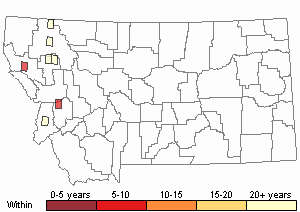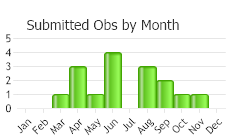View in other NatureServe Network Field Guides
NatureServe
Montana
Utah
Wyoming
Idaho
Wisconsin
British Columbia
South Carolina
Yukon
California
New York
An Antitrichia Moss - Antitrichia curtipendula
Other Names:
Antitrichia curtipendula var. gigantea
General Description
Plants: Pleurocarpous (Vitt 1988), growing in sometimes deeply interwoven mats, widespreading; straw-colored to ochre when dry, vivid green when wet. Secondary stems ascending, irregularly pinnate, 10-20 cm; lateral branches up to 3 cm, occasionally drooping, slender and whip-like distally, sometimes producing branchlets up to 3 cm in length (FNA 2014).
Leaves: Stem leaves not quite erect when dry, erect-spreading when wet, ovate-lanceolate or much broader (FNA 2014), 2-3.8 mm in length, concave; margins extremely revolute almost to the apex, the apical portions finely toothed to nearly entire; apex acuminate or acute; costa nearly 3/4 the leaf length (Lawton 1971), 2-lobed above; commonly 2-3 supplementary costae with length of more than 6 cells occurring on both sides of main costa. Branch leaves similar to but smaller and narrower than stem leaves (FNA 2014).
Leaf Cells: Stem leaf cells porose; alar cells nearly square to transversely rectangular. Perichaetial leaves have thin-walled rectangular basal cells, 4-5:1, and wavy, elongated medial cells, up to 10:1 (FNA 2014).
Some authors consider all western North American plants of A. curtipendula, particularly the larger plants found along the Pacific coast, to be A. curtipendula var. gigantea. Others consider the more massive plants as environmental variations of A. curtipendula (FNA 2014).
Diagnostic Characteristics
A. curtipendula, when large and growing on logs and rocks, may be mistaken for Rhytidiadelphus species. The latter, however, appear shaggier.
The revolute leaf margins and lack of a single strong costa are good field identification attributes for Antitrichia (Vitt 1988).
Range Comments
Greenland; Canada: BC, NL; USA: AK, CA, ID, MT, OR, WA; Europe; w Asia; e Africa (montane); Atlantic Islands. In Montana, A. curtipendula is found growing in the maritime-influenced cedar-hemlock-larch ecozones (FNA 2014), and is known from Flathead, Lake, Lincoln, Meagher, and Sanders Counties (Elliott 2016).
Observations in Montana Natural Heritage Program Database
Number of Observations: 16
(Click on the following maps and charts to see full sized version)
Map Help and Descriptions
Relative Density

Recency



 (Observations spanning multiple months or years are excluded from time charts)
(Observations spanning multiple months or years are excluded from time charts)
Habitat
Rotton wood, soil, humus, and rock at low to high elevations (FNA 2014; Elliott 2014).
Reproductive Characteristics
Dioicous. Seta 8-15 mm. Capsule brown to ochre, 4-5 mm in length (FNA 2014).
References
- Literature Cited AboveLegend:
 View Online Publication
View Online Publication Elliott, J.C. and A.K. Pipp. 2018. A Checklist of Montana Mosses (1880-2018). Updated 3 January, 2020. Montana Natural Heritage Program, Helena, Montana. 73 pp.
Elliott, J.C. and A.K. Pipp. 2018. A Checklist of Montana Mosses (1880-2018). Updated 3 January, 2020. Montana Natural Heritage Program, Helena, Montana. 73 pp. Flora of North America Editorial Committee, eds. 2014. Flora of North America North of Mexico. Volume 28. Bryophytes: Mosses, Part 2. Oxford University Press, Inc., NY. xxi + 702 pp.
Flora of North America Editorial Committee, eds. 2014. Flora of North America North of Mexico. Volume 28. Bryophytes: Mosses, Part 2. Oxford University Press, Inc., NY. xxi + 702 pp. Lawton, E. 1971. Moss Flora of the Pacific Northwest. Hattori Botanical Laboratory. Japan: Yamabuki-cho, Shinjuku-ku, Tokyo. 362 pages plus appendices.
Lawton, E. 1971. Moss Flora of the Pacific Northwest. Hattori Botanical Laboratory. Japan: Yamabuki-cho, Shinjuku-ku, Tokyo. 362 pages plus appendices. Vitt, D. J. Marsh, and R. Bovey. 1988. Mosses, Lichens & Ferns of Northwest North America. Seattle, WA: University of Washington Press. 296 p.
Vitt, D. J. Marsh, and R. Bovey. 1988. Mosses, Lichens & Ferns of Northwest North America. Seattle, WA: University of Washington Press. 296 p.
- Additional ReferencesLegend:
 View Online Publication
View Online Publication
Do you know of a citation we're missing? Elliot, J. C. 1993. Second checklist of Montana mosses. Unpublished report. U.S. Forest Service, Region 1. Missoula, MT. 45 pp.
Elliot, J. C. 1993. Second checklist of Montana mosses. Unpublished report. U.S. Forest Service, Region 1. Missoula, MT. 45 pp. Lawton, E. 1971. Keys for the Identification of the Mosses on the Pacific Northwest. Reprinted from 'Moss Flora of the Pacific Northwest'. Published as Supplement No. 2 of the Journal of the Hattori Botanical Laboratory. Nichinan, Miyazaki, Japan. 66 pp.
Lawton, E. 1971. Keys for the Identification of the Mosses on the Pacific Northwest. Reprinted from 'Moss Flora of the Pacific Northwest'. Published as Supplement No. 2 of the Journal of the Hattori Botanical Laboratory. Nichinan, Miyazaki, Japan. 66 pp.
- Web Search Engines for Articles on "An Antitrichia Moss"





